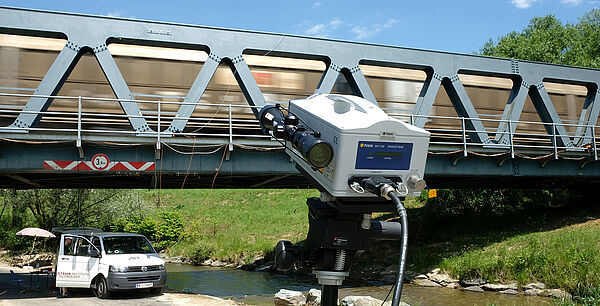In a recent press release, Federal Minister Peter Hanke highlights the central role of the AIT Austrian Institute of Technology in developing innovative monitoring and assessment methods for Austria's infrastructure. Bridges, dams, tunnels, and railways form the backbone of mobility—many of them date back to the 1960s and 1970s and are now facing comprehensive maintenance cycles.
"To both ensure the safety and stability of the structures and avoid costly new constructions, we are relying on innovation with the AIT. Currently, a large-scale research project is starting with NINA, which aims to intelligently extend the lifespan of existing structures through innovative monitoring and assessment methods – without compromising operational safety," explains Minister of Innovation and Infrastructure Peter Hanke.
For years, AIT has been researching intelligent solutions to use existing structures longer, more safely, and more sustainably. This involves the use of state-of-the-art sensor, satellite, and AI technologies that make changes in condition visible at an early stage and enable data-based decisions.
One example of this is the new NINA research project, in which methods for the early detection of damage and for predicting the service life of prestressed concrete bridges are being developed in collaboration with the Vienna University of Technology, Graz University of Technology, and industry partners. Combined with digital twins and acoustic and fiber optic measurement systems, this creates a precise picture of the condition of the structure in real time—an essential step toward preventive, data-based structural maintenance.
"Every bridge that we can safely use for ten more years not only saves money but also thousands of tonnes of CO₂. The bridges of the future are already built – now it's about using them intelligently for longer or implementing sustainable, targeted interventions at the optimal time," states Hanke.
Digital technologies for predictive building maintenance
In the SENBRIDGE and BOOST projects, AIT and ASFINAG demonstrated how bridge movements can be measured with millimeter precision using ESA satellite data and radar interferometry (InSAR) – without the need for local sensors.
A similar approach is being applied to flood protection dams in the HoSMoS project. In the COMET project Rail4Future, led by ÖBB, AIT also developed a digital simulation platform that can be used to virtually evaluate bridges and tracks and accurately estimate their remaining service life.
Sustainability through knowledge instead of new construction
Longer-lasting structures not only mean greater safety, but also make an important contribution to climate protection: an average bridge binds around 2,000 tons of CO₂. Targeted maintenance strategies can significantly reduce these emissions.
"Research in this area is crucial to extend the lifespan of our infrastructure," emphasises University Professor Andreas Kugi, Scientific Director of AIT. "With innovative measurement and analysis methods, we create the basis for targeted, resource-efficient maintenance measures and thus make a significant contribution to safety, efficiency, and sustainability."
With projects such as NINA, SENBRIDGE, BOOST, HoSMoS, FOSSURE, and Rail4Future, AIT is driving the transformation toward resilient, digital, and climate-fit infrastructure—and thus making a decisive contribution to the sustainable mobility of the future.
To the BMIMI press release: https://www.bmimi.gv.at/en/service/press/releases/2025/1030_bridge.html



